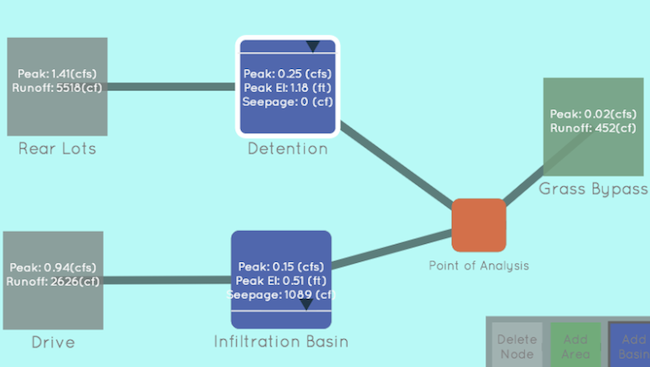I’m a big fan of stormwater – that is, I enjoy being part of an engineering niche dedicated to mitigating pollution caused by stormwater runoff. Actual stormwater, the pollutant-laden wet stuff that is the bane of many modern cities’ existence, is not very nice. To help make stormwater management computations easier, I created Hydrographs, a free stormwater modeling web app to help engineers and landscape architects size stormwater management practices.
My professional relationship with stormwater began after finishing an environmental engineering graduate program in 2011 at Philadelphia’s Drexel University. Since then, I’ve started work as a consultant in the Philadelphia stormwater industry and have spent a lot of time with various modeling tools while tinkering with computer programming on my nights off.
After a few years of working with stormwater models, however, I gradually found myself growing weary and frustrated with the clunky, Windows-95-esque stormwater software. I started to think to myself: “Why shouldn’t the stormwater niche enjoy intuitive and user-friendly software found in other industries? Why are stormwater professionals still printing out 200 pages (single-sided!) of 99% useless stormwater flow data in 2014? Think of the trees!”
Since I had some background in software design, I decided to try and create a new stormwater modeling tool that would not only be more efficient than the industry’s existing stormwater software, but would also be completely paper-free. Thus, the Hydrographs tool was born.
Hosted on the cloud, Hydrographs is a free resource to store and share stormwater models that makes use of the Curve Number method and the SCS Unit Hydrograph method to compute runoff hydrographs. Users can quickly construct models with a drag-and-drop routing diagram and sliders to adjust parameters defining each model element. Engineers and landscape architects can use the software to design and size simple stormwater management practices (SMPs) to reduce the impact of stormwater runoff from a particular site. Currently, Hydrographs supports SMPs with or without infiltration, with customizable outlet controls.
My goal is to provide a sound engineering tool, while maintaining a highly visual and intuitive user interface. Leveraging the power of the internet, my hope is to provide a modern way of compiling and distributing models and reports to colleagues and regulators. The cloud-based storage and sharing functionality provides a means for those working in stormwater management to save their work in the cloud and share their progress with a simple short-link. These models can then be shared with anyone with an internet connection, eliminating the waste and expense of printing and mailing bulky modeling reports.
Hydrographs is available for free on modern web browsers worldwide at www.hydrographs.com (not compatible with Internet Explorer). Because this is an evolving, work in progress, I invite anyone interested to provide feedback and requests for added functionality. I’d love for you to get involved and can’t wait to hear your ideas!
Adam Erispaha is an Environmental Engineer at Sci-Tek Consultants in Philadelphia. You can get started with Hydrographs here or find out more information here.
Published in Blog












Mitch Howard
Hello Adam – First of all, this is a great and very helpful tool. Thank you for this generosity. Is there a book (or books) that you would recommend to LAs that could be used to further educate them as to the ins and outs (all puns intended) of stormwater runoff and management?
Adam Erispaha
Hi Mitch, Thanks a lot for your feedback. I’m really glad this is helpful to you.
Unfortunately, I’m still on the search for a hydrology book that I really like. In school I started with “Intro to Hydrology” by Viessman and Lewis, but I found it spotty. I might suggest checking out TR-55 which defines the Curve Number method, a widely used procedure for calculating stormwater runoff. It’s the basis for a lot of popular stormwater modeling programs and is integrated in a lot stormwater regulations in the US. The Curve Number wiki page is also a nice resource. Overall I feel like there is a lack clear resources, though.
Mitch Howard
Thanks Adam for the links. If you do come across that one great hydrology book, please let us all in on it.
Hilary Ann Noonan
Adam,
My issue with TR-55 is that it doesn’t read water if you are working with less than an ac ft. I do my own calcs- rational method- because i haven’t found a program that will read water before it gets destructive. I haven’t tried the Hydrograph, but I have signed up. Can you tell me how it does with smaller amounts of water?
Cheryl Corson
Great! Can’t wait to try it out.Thank you.
Adam Erispaha
Hi Hilary,
In theory, it’s possible to input any storm depth into the curve number method, but my understanding is that its “calibrated” for larger storms (I think 1 inch and above is the rule of thumb). My tool, Hydrographs, currently allows storms a small as 0.5 inches, for the daring. You can also make the areas as small as you’d like. Shoot me an email if you’d like more help or explanation.
Baldev Lamba
Hi Adam:
As the Chair of education committee, I would like to discuss the possibility of a presentation/demo/application of this modelling option for the PA/DE Chapter of the American Society of Landscape Architects. Thanks. Baldev